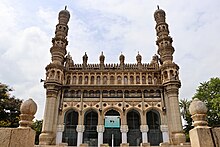
Toli Masjid

| Toli Masjid | |
|---|---|
 | |
| Religion | |
| Affiliation | Islam |
| Status | active |
| Location | |
| Location | Golconda Road, Karwan, Hyderabad |
| State | Telangana |
| Country | India |
| Geographic coordinates | 17°22′29″N 78°26′20″E / 17.37461°N 78.43897°E |
| Architecture | |
| Type | mosque |
| Style | Qutb Shahi |
| Completed | 1671 CE |
| Specifications | |
| Minaret(s) | 2 |
| Minaret height | 60 feet (18 m) |
Toli Masjid, also known as Damri Masjid, is a mosque in Hyderabad, in the Indian state of Telangana. It was constructed during the Qutb Shahi period and completed in 1671.[1]

Built in the distinctive Qutb Shahi style, the mosque displays considerable Hindu influences in its style. Its chief feature is its extensive ornamentation, consisting of latticed screens, chajjas, stucco work, and various other motifs.[2][3] It is located on the historically significant Karwan road, and was originally set in a garden.[4] It is listed as a state protected monument.[5]

History
The mosque was commissioned by Musa Khan during the reign of Abdullah Qutb Shah, and completed in 1671. Musa Khan was the mahaldar (chamberlain) of Abdullah, as well as a minister and general. According to the historical record Gulzar-e-Asafiyah, when Musa Khan held the construction charge for the Mecca Masjid, he was provided with a discount of one damri per rupee from the building expenditure. He used this amount to construct the Toli Masjid, hence the name.[note 1][1]

The mosque is located at Karwan, on the road which connects Golconda Fort to Purana Pul.[4] This road is historically significant as it connected the citadel of Golconda to the newly established city of Hyderabad.[6] It is listed as a state protected monument.[5] The lands endowed to the mosque have been encroached,[7][8] and the mosque is in a neglected condition.[9]

Architecture


The Toli Masjid is an example of late Qutb Shahi architecture. Built in the typical Qutb Shahi style, its chief feature is its exuberant decoration, considered a culmination of the decorative tendencies seen in earlier Qutb Shahi mosques.[2]

The mosque displays considerable Hindu influences in its style. These include the use of excessive ornamentation, as well as elements such as elephant-tusk brackets and pot-shaped bases for the minarets. The niches in the post and lintel style are similar to those in temples used to accommodate images. Additionally, the parapet wall is decorated with miniature minarets just as miniature shikharas are seen in temples.[10]

Exterior

The Toli Masjid is built on a raised platform with a high plinth, which forms the courtyard of the mosque. This courtyard, about 6 feet (1.8 m) tall, is accessible by flights of steps from the north, south, and east. Musa Khan's grave is situated near the south-eastern end of the courtyard.[11] The mosque building, 4 feet (1.2 m) higher, is located at the western end. The lower part of the building is constructed from ashlar masonry, while the upper part is built out of brick and lime, probably to carry cut-plaster decoration. Granite and black basalt are used for embellishment.[3][9]

The façade has five arched openings, the central arch being a bit wider and more ornate than the other four. Five-arched façades are common in Qutb Shahi mosques, with the number five symbolizing the Panjtan.[12] Decorative granite columns start at each arch and reach up to the roof. This decoration consists of basalt medallions on either side of the arch, and stucco ornamentation. This is followed by eaves in the form of a chajja, which are supported by beams and brackets. Finally, a double parapet wall rises above the building, consisting of a series of arched windows, decorated with jali work. Miniature minarets rise above the parapet wall.[2][3][9]

The façade is flanked by two minarets, about 60 feet (18 m) tall. The pillars at the corners consist of pot-shaped bases, which support octagonal shafts upon which the minarets rise. The minarets have three sets of galleries, and the central gallery is provided with a balcony, decorated with foliate elements. Each minaret is topped by a dome and finial. The ceiling above the inner hall is surmounted by three flattish domes.[1][2][6]

The mosque was originally set in a large garden, of which little trace remains. A stepwell is also located within the premises.[13]

Interior
The mosque is divided into two halls—the outer hall having five arched openings, and the inner having only three. On the western wall of the inner hall, the prayer niche is in the form of a semi-decagon.[10] A Persian inscription in the Naskh script is engraved on the prayer niche.[14] The inscription reads:

For whom is the Kingdom today? For God, the One, the All-powerful.
Musa Khan built this mosque of his
Which was completed in the reign of Shah Abdullah.
As a chronogram of the mosque this was heard (from the Invisible Speaker):
"Built the mosque in the name of God." 1082 AH (1671 CE)
— translated by Ghulam Yazdani[14]
See also
- Kulsum Begum Masjid, located on the same road
- Mian Mishk Mosque
- Musheerabad Mosque
References
Notes
Citations
- ^ a b c Bilgrami 1927, p. 67.
- ^ a b c d Michell, George; Zebrowski, Mark. Architecture and Art of the Deccan Sultanates (PDF). The New Cambridge History of India I : 7. Cambridge University Press. p. 105. Retrieved 25 July 2023.
- ^ a b c Yazdani 1918, pp. 3–5.
- ^ a b Bilgrami 1927, p. 65.
- ^ a b "The Telangana Heritage (Protection, Preservation, Conservation and Maintenance) Act, 2017" (PDF). The Telangana Gazette. Retrieved 25 July 2023.
- ^ a b Sastry, V. V. Krishna (1982). Select Monuments of Hyderabad (PDF). Hyderabad: Ramesh Printers & Publishers. p. 38.
- ^ "'Toli Masjid land encroached'". The Hindu. Chennai, India. 23 September 2008. Archived from the original on 25 September 2008.
- ^ Minhaz, Ayesha (2 February 2015). "17 acres of 343-year-old Toli Masjid encroached". Deccan Chronicle. Retrieved 25 July 2023.
- ^ a b c Iyer, Lalita (16 June 2018). "Hyderabad: At 350-year-old Toli Masjid, time for quiet reflection". Deccan Chronicle. Retrieved 25 July 2023.
- ^ a b Yazdani 1918, p. 4.
- ^ "Toli Masjid". Department of Heritage, Telangana.
- ^ Jayyusi, Salma K.; Holod, Renata; Petruccioli, Attilio; Raymond, Andre (2008). The City in the Islamic World, Volume 94/1 & 94/2. BRILL. p. 612. ISBN 978-90-04-16240-2.
- ^ Kashyap, Aarti (7 December 2022). "350-year-old stepwell in Hyderabad's Old City begs for attention". Deccan Chronicle. Retrieved 25 July 2023.
- ^ a b Yazdani, Ghulam (1921). Epigraphica Indo-Moslemica. Calcutta: Superintendent Government Press. p. 50.
Bibliography
- Bilgrami, Syed Ali Asgar (1927). Landmarks of the Deccan. Hyderabad: Government Central Press. pp. 65–67.
- Yazdani, Ghulam (1918). Annual Report of the Archaeological Department of His Exalted Highness The Nizam's Dominions (PDF). Calcutta: Baptist Mission Press. pp. 3–5. Retrieved 25 July 2023.
- Mosques in Hyderabad, India
- Tourist attractions in Hyderabad, India
- Heritage structures in Hyderabad, India
- 1671 establishments in India
- Mosques completed in the 1670s
- Religious buildings and structures completed in 1671
- Qutb Shahi architecture
- 17th-century mosques in India
- Mosque buildings with minarets in India
See what we do next...
OR
By submitting your email or phone number, you're giving mschf permission to send you email and/or recurring marketing texts. Data rates may apply. Text stop to cancel, help for help.
Success: You're subscribed now !





